
Glendalough is a glacial valley in County Wicklow, Ireland, renowned for an Early Medieval monastic settlement founded in the 6th century by St Kevin. From 1825 to 1957, the head of the Glendalough Valley was the site of a galena lead mine. Glendalough is also a recreational area for picnics, for walking along networks of maintained trails of varying difficulty, and also for rock-climbing.
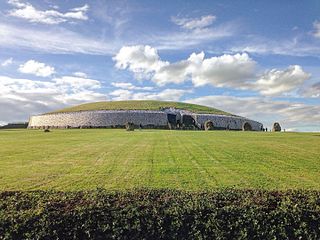
Newgrange is a prehistoric monument in County Meath, Ireland, located 8 kilometres (5.0 mi) west of Drogheda on the north side of the River Boyne. It is an exceptionally grand passage tomb built during the Neolithic period, around 3200 BC, making it older than Stonehenge and the Egyptian pyramids.

The Celtic cross is a form of Christian cross featuring a nimbus or ring that emerged in Ireland, France and Britain in the Early Middle Ages. A type of ringed cross, it became widespread through its use in the stone high crosses erected across the islands, especially in regions evangelized by Irish missionaries, from the 9th through the 12th centuries.

Poets' Corner is the name traditionally given to a section of the South Transept of Westminster Abbey because of the high number of poets, playwrights, and writers buried and commemorated there.

A stele, or occasionally stela, when derived from Latin, is a stone or wooden slab, generally taller than it is wide, erected in the ancient world as a monument. The surface of the stele often has text, ornamentation, or both. These may be inscribed, carved in relief, or painted.

Saggart is a village in South Dublin, Ireland, south west of Dublin city. It lies between the N7, Rathcoole, Citywest and Tallaght. It is one of the fastest growing settlements in Ireland, showing a population increase of 46.1% between 2011 and 2016.

The Georgia Guidestones are a granite monument erected in 1980 in Elbert County, Georgia, in the United States. A set of ten guidelines is inscribed on the structure in eight modern languages and a shorter message is inscribed at the top of the structure in four ancient language scripts.
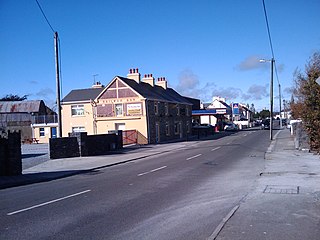
Lixnaw is a village in North County Kerry, Ireland. It is located near the River Brick 11 km (6.8 mi) SW of Listowel and 17 km (11 mi) NE of Tralee.

Roughly 400 known ogham inscriptions are on stone monuments scattered around the Irish Sea, the bulk of them dating to the fifth and sixth centuries. Their language is predominantly Primitive Irish, but a few examples record fragments of the Pictish language. Ogham itself is an Early Medieval form of alphabet or cipher, sometimes known as the "Celtic Tree Alphabet".

Reask is a ruined early Monastic site located 1 km east of Baile an Fheirtéaraigh, County Kerry, Ireland. Although nothing remains of the buildings but low walls and a cross-slab standing stone which sits in the middle of the compound, this site gives a very good idea of the layout of a small monastery of the Early Medieval period.
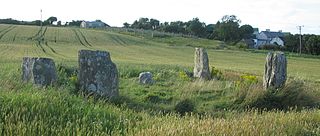
Templebryan Stone Circle is a stone circle, located 2.5 km (1.6 mi) north of Clonakilty, County Cork, Ireland. Grid ref: W386 438. Close by lies an Early Christian site.

The Meigle Sculptured Stone Museum is a permanent exhibition of 27 carved Pictish stones in the centre of the village of Meigle in eastern Scotland. It lies on the A94 road running from Coupar Angus to Forfar. The museum occupies the former parish school, built 1844. The collection of stones implies that an important church was located nearby, or perhaps a monastery. There is an early historical record of the work of Thana, son of Dudabrach, who was at Meigle in the middle of the 9th century during the reign of King Pherath. Thana was likely to have been a monk serving as a scribe in a local monastery that could have been founded in the 8th century. The stones contained in the museum were all found near Meigle, mostly in the neighbouring churchyard or used in the construction of the old church. The present church building dates to about 1870, the previous building having been destroyed in a fire on 28 March 1869. The stones were rescued by William Galloway immediatey after the fire. The stones are Christian monuments to the dead of the Pictish warrior aristocracy, who are depicted on the stones bearing their weapons or hunting.
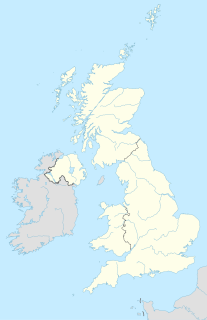
Derry is a townland in the civil parish of Ballyphilip in the barony of Ards Upper, County Down, in Northern Ireland. It is near Portaferry on the Ards Peninsula. The townland has remains of two small ruined churches.

Margam Stones Museum is a small Victorian schoolhouse near Port Talbot, South Wales, which now provides a home for one of the most important collections of Celtic stone crosses in Britain. All originally found within the locality of Margam, and mostly assembled as a collection in the 19th century, they provide enduring testimony to a Welsh Christian culture between the 6th and 16th centuries. The striking Cross of Conbelin is the most celebrated example. From around 1000 AD, it is a huge disc cross with Celtic interlace and plaitwork patterns, figurative scenes including a hunting scene, and inscriptions telling us who made it and who erected it. There are 17 early Christian stones, plus 11 memorials and other stones from the post-Norman periods. The museum is run by Cadw, the Welsh historic sites agency, and is close to Margam Abbey Church and the ruins of the Abbey buildings.
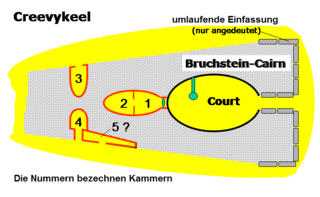
Creevykeel Court Tomb is one of the finest examples of a court tomb remaining in Ireland. The monument is located in the N15 Donegal to Sligo road, 200 meters north of Creevykeel cross-roads close to Cliffoney village in County Sligo. The original name for the Creevykeel monument is Caiseal an Bhaoisgin, the Fort of Bhaoisgin, Tober an Bhaoisgin being the name of the well near the cairn. A second megalithic monument existed 300 meters to the north, but it was demolished around 1890.

A ledger stone or ledgerstone is an inscribed stone slab usually laid into the floor of a church to commemorate or mark the place of the burial of an important deceased person. The term "ledger stone" derives from the German word legen, meaning to lie. Ledger stones may also be found as slabs forming the tops of tomb chest monuments.

Odhran Ua hEolais was a medieval scribe and scholar at the abbey of Clonmacnoise. He must have been born, and lived his childhood, in the kingdom of Conmaicne Magh Réin, which corresponds to present day south county Leitrim. We do not know any significant details of his personal life, but Odhran moved to county Offaly in adult life, to become Lector and a famous scriba of Clonmacnoise. His death is recorded in the Annals of the Four Masters. A cross-stone of Odhran, with his name inscription legible in middle Irish, is preserved to this day.
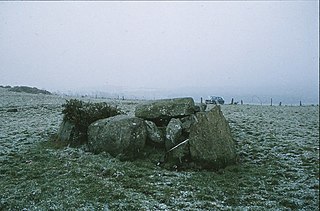
Matthewstown Passage Tomb is a passage tomb situated in County Waterford, Ireland.

St. Manchan's Oratory, also called An Teampall Geal is a medieval oratory and National Monument in County Kerry, Ireland.

Labbamolaga Church is a medieval church and National Monument located in County Cork, Ireland.




















